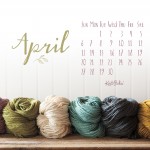I love our new yarn Hawthorne.
 You probably could tell because I wouldn’t shut up about it on our latest podcast. Since I’ve been using it like crazy in several projects, I thought I’d share some tips & tricks for working with what can be a challenging yarn to some people – hand painted yarn.
You probably could tell because I wouldn’t shut up about it on our latest podcast. Since I’ve been using it like crazy in several projects, I thought I’d share some tips & tricks for working with what can be a challenging yarn to some people – hand painted yarn.
Hawthorne is an even more interesting hand painted yarn than others you may have seen and used – it’s actually hand dyed in two stages, the first is tonal and the second multi-hued, to create a beautiful painterly effect with a bright pop of color. This yarn is all completely hand dyed – so each skein can be unique with awesome variations. They are lovely to look at – as well as to knit or crochet with. This is the Vancouver colorway all skeined up.
Pooling is the nemesis of many fans of hand painted yarns. This is where a color will stack up, creating a blotches in your project. Here’s an example with the Vancouver colorway again knitted up (and taken with my camera) – this swatch is 64 stitches across, knitted back & forth at 8 stitches per inch.
I got this effect on my Sockhead hat I knit in Concordia, but I rather like it. The pooling reminds of lighting bolts.
But if you don’t want this look, there are a couple of things you can do. First is to swatch (I know, that’s boring) – use different needles and different stitch counts to see what you like. For example, for the swatch we used on the site for the Vancouver colorway, we went down to 32 stitches back & forth at 8 stitches per inch (to get a better idea of how it would look like at 64 stitches in the round).
Another thing you can do, especially for hats or larger accessories or garments is to alternate skeins – either from an additional skein, winding a skein into 2 cakes, or working both ends of the yarn cake. For projects in the round, you’ll want to switch every round – for a vest I made a few years back, I just placed an extra marker on the side to remind me to switch yarns. For working back and forth, switch every other row. It’s a simple way to break up any colors and if you carry your yarn up each round or row, you won’t have any additional ends to weave in. Since there can be color variations from skein to skein because of the hand dyed nature, this method is the best way to even out the color distribution.
There are also many sock patterns that have stitch patterns that are designed to show off hand painted yarns. Two of my favorite sock books are great for this – Indie Socks by Chrissy Gardiner and Socktopus by Alice Yu. Both are filled with tips & tricks for working with hand painted yarns as well as some fantastic patterns – I think Chrissy’s Supernova pattern would look great in Hawthorne.
(also both books are on sale for 40% off right now!)
For my socks, I opted with an old favorite – Monkey by Cookie A. I’ve used this pattern a lot so I knew it was great for hand painted yarns. I went with the Alameda colorway for mine and I just love them so much.
Oh, and in case you were wondering – that yarn at the top was how much I had left after I completed these socks for my size 10 feet with a 6 inch cuff. There’s about 4 grams left, which makes me happy because I dislike having a lot of random sock yarn leftovers taking up room in my stash.
See how the stitch pattern broke up any kind of pooling?
Another method some folks use is intentional pooling, where you deliberately pool the yarn into designs such as horizontal stripes, argyle, or other interesting patterns. This does take quite a bit of preparation (and swatching) but the results are incredible – check out groups on Ravelry such at pooled knits for examples of projects & tips on how to create these projects yourself.
So with these tips, I hope you’ll love Hawthorne as much as we do – I’m all ready to start my next project in it. It’s really got back me back into knitting socks again – I hadn’t been for quite awhile but now I want a pair in every color!
Do you have other tricks for using hand painted yarns? Leave them in the comments!











